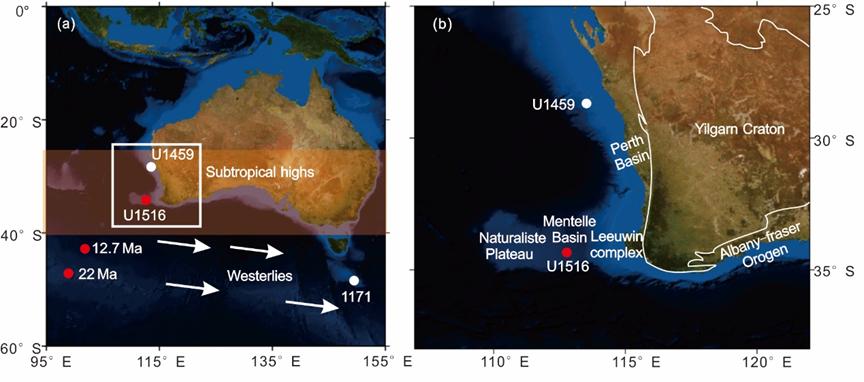
In the context of global warming with rising atmospheric carbon dioxide (CO2) levels and melting polar ice, reconstruction of paleoclimatic and paleoenvironmental history during past periods when the Earth's climate system changed dramatically is significant for understanding climate mechanism and thus improving predictions of the future.
At present, deep-sea sediments provide scientists with an ideal perspective to decode paleoclimatic and paleo-environmental history.
The Miocene, 23 to 5 million years ago, was an important period for the formation of the Antarctic ice sheets (AIS). Recently, a research team led by Prof. LI Tiegang from the Institute of Oceanology of the Chinese Academy of Sciences (IOCAS) has used deep-sea sediments offshore southwest Australia to reconstruct paleoclimatic evolution in the middle latitudes of the southern hemisphere in this period.
This history builds an important bridge between the evolution of the westerlies and the AIS. It also provides evidence for the transmission of Antarctic signals to lower latitudes when there were only the unipolar ice sheets developing on the Earth.
The study was published in Science China Earth Sciences on Apr. 22.
In 2017, the International Ocean Discovery Program (IODP) drilled deep-sea sediment cores from the Mentelle Basin in the southeast Indian Ocean. Scientists from IOCAS combined the analysis of the siliciclastic mass accumulation rate, grain size, clay minerals, and elemental composition of the sediments to reconstruct the paleoclimatic evolution in the middle latitudes of the southern hemisphere.
Due to the northward drift of the Australian plate since the Cenozoic, the Mentelle basin and Australia were closer to Antarctica in the Miocene than it is now. At the same time, the westerlies have been prevailing in the middle latitudes of the southern hemisphere and playing an important role in the precipitation of southwest Australia. That makes the Mentelle basin an ideal target area for studying the interaction among the cryosphere, hydrosphere, as well as lithosphere, and atmosphere.
Results showed that the amount of terrigenous material transported from southwest Australia to the ocean increased significantly, and the contribution of the fluvial component was more than that of the aeolian dust component 13 million years ago. "It became wetter and the continental chemical weathering became stronger in southwest Australia after the late middle Miocene," said Prof. LI.
The researchers also found that this significant climate transition of Australia occurred right after the permanent formation of AIS with the dramatic decline of deep-sea temperatures and remarkable expansion in zonal and meridian sea surface temperature gradients. Meanwhile, the South Asian monsoon system enhanced abruptly. "These consistent changes might indicate the transmission of Antarctic signals along the ocean and atmosphere to lower latitudes," said SUN Tianqi, first author of the study.
"In the future, we will then combine Nd isotopes of seawater to study the impact of AIS expansion on ocean circulation in the Indian Ocean," said Prof. LI.
This research was supported by the Strategic Priority Research Program of the Chinese Academy of Sciences and the National Natural Science Foundation of China.

Site location and geological background off the southwest coast of Australia. (Image by IOCAS)

86-10-68597521 (day)
86-10-68597289 (night)

52 Sanlihe Rd., Xicheng District,
Beijing, China (100864)

